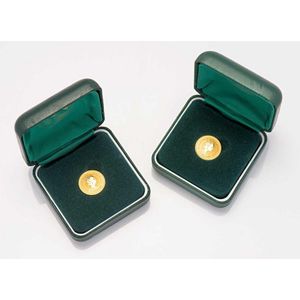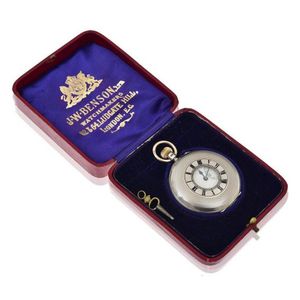J.W. Benson Half Hunter Pocket Watch with Original Box
You must be a subscriber, and be logged in to view price and dealer details.
Subscribe Now to view actual auction price for this item
When you subscribe, you have the option of setting the currency in which to display prices to $Au, $US, $NZ or Stg.
- Hunter - A hunter pocket watch is the type where the case includes a spring-hinged circular metal lid or cover, that closes over the glass face of the watch, protecting it from dust, scratches and other damage or debris. The majority of antique and vintage hunter-case watches have the lid-hinges at the 9 o?clock position, suiting the right handed user.
- Engine Turned - Engine turning is a decorative technique used on metal surfaces to create intricate curving or geometric pattern. The process involves cutting a series of lines into the surface of the metal using a rose engine or decoration lathe which rotates the metal as it cuts, allowing the operator to create a repeating pattern that covers the entire surface. The resulting surface has a shimmering, reflective quality that is often described as "engine turned." Where an engine turned item has been enamelled, the term used to describe the decoration is usually guilloche.
Engine turning was originally developed to decorate metal objects such as firearms, scientific instruments, and other metal objects that required precise and elegant design. - Half Hunter - A half-hunter (or "demi hunter") pocket watch is one in which the outer lid over the face of the watch has a cut out centre section, enabling the owner to view the hands to tell the time, without having to open the lid. On some half-hunter watches, the hours are marked on the outer lid.
- Sterling Silver - Sterling silver is a mixture of 92.5% pure silver and 7.5% of another metal, usually copper. Fine silver is 99.9% pure silver, and is relatively soft and the addition of the very small amount of copper gives the metal enough strength and hardness to be worked into jewellery, decorative and household objects.
This item has been included into following indexes:
- Benson, J. W. (England)
Visually similar items

A presentation case containing a 68 mm (161g) 'Pour Services Rendus' bronze medal awarded to 'Petitgand' accompanied by a 37 mm (21g) bronze medal; both by Ponscarme.

Loose diamond 0.62ct with diamond grading certificate

A vintage brooch by Hermes, with equestrian and foliate design in cream and light brown, on a blue enamel background, with a gilt border, with box

Two Australian Fifteen Dollar gold coins, inscribed 'Australian nugget 1/10 oz' and dated 1995 and 1996. Total weight 6.24 grams. Length 16 mm. Original box and outer box.
